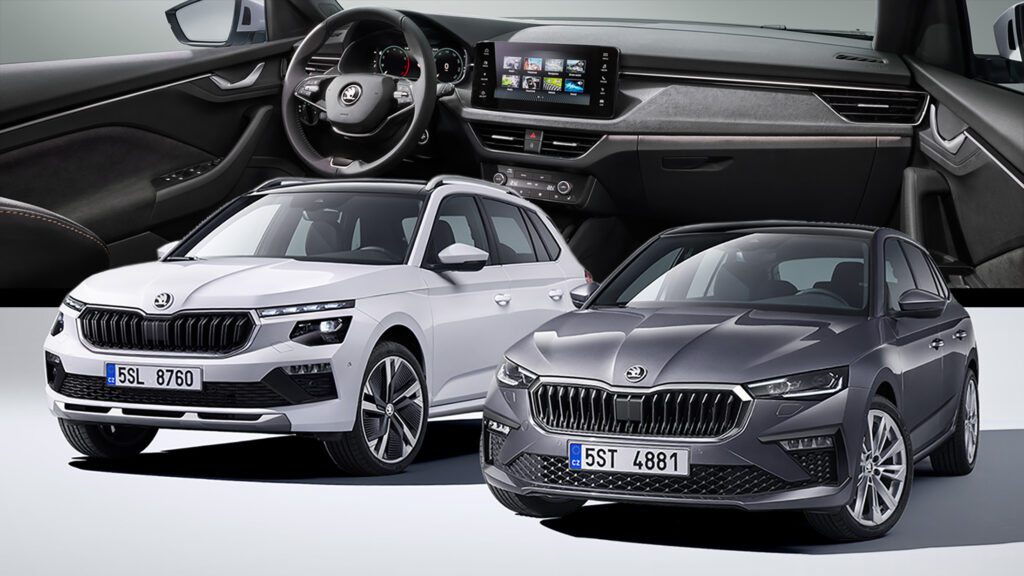The mechanically-related models might look very similar to their predecessors at first glance, but they hide some welcome updates
3 hours ago
 –>
–> 
–>
Skoda updated the Scala compact hatchback and the Kamiq B-SUV bringing small improvements in the styling, technology, safety, sustainability, and efficiency departments, four years after their original debuts.
From the outside, the Scala and the Kamiq are both instantly recognizable since the designers opted for an evolutionary approach. Changes are focused on the new faces, including the redesigned headlights which are optionally available with Matrix-LED technology, and the slightly tweaked grilles and bumpers. In the Scala, the headlights have crystalline modules looking like “sparkling little blocks of ice or gemstones” while in the Kamiq the split headlights are slimmer.
More: 2024 Superb Promises To Be The Most Spacious And Technologically Advanced Skoda Ever
advertisement scroll to continue
The profiles are carried over with new designs for the alloy wheels measuring up to 18 inches, while the rear ends have been updated with new LED graphics for the taillights and fresh bumpers. Furthermore, the sportier-looking Monte Carlo trims are distinguished by the high-gloss black accents all around the bodywork, the tinted windows, the standard LEDs, and the optional 18-inch Ursa alloy wheels. Those are combined with faux carbon trim, red details, sports seats, ambient lighting, and Monte Carlo graphics inside the cabin.
Speaking of the interior, the layout remains unchanged but is infused with more tech and sustainability. The 8-inch digital instrument cluster and 8.25-inch touchscreen are standard equipment, while higher-spec models get a larger 10.25-inch Virtual Cockpit and a 9.2-inch infotainment combo. Of course, Skoda’s signature Simply Clever features couldn’t be missing from the game.
Staying true to the trend of our times, the automaker added “an increased proportion of recycled and natural materials” to the interior and the exterior, improving the sustainability credentials of the Scala and the Kamiq. Safety is also upgraded with up to 9 airbags and an extended suite of available ADAS. The new trim structure includes 3 trim levels (Essence, Selection, and Monte Carlo) and 6 interior configurations, plus a variety of optional equipment packages.
Both models are based on a stretched version of the MQB-A0 architecture, which is shared with the likes of the VW Polo / T-Cross, Skoda Fabia, and Seat Ibiza / Arona. The powertrain lineup is largely carried over from the pre-facelifted range, albeit now using the evo2 versions of the widely used TSI petrol engines. There are no hybrid or diesel options while the CNG-fueled G-Tec variants are not mentioned in the press release.
The entry-level 1.0-liter TSI three-cylinder petrol produces 94 hp (70 kW / 95 PS) and is exclusively mated to a 5-speed manual gearbox. The mid-range 1.0 TSI produces a more potent 113 hp (85 kW / 115 PS) and offers a choice between a 6-speed manual and a 7-speed DSG. Finally, the flagship 1.5-liter TSI four-cylinder makes 148 hp (110 kW / 150 PS) and features ACT cylinder deactivation tech, while also being available with manual or automatic gearbox. Independently of the engine and gearbox combination, all Scala and Kamiq variants are front-wheel-drive.
Skoda offers three different chassis setups for each model, tailoring them to the needs of their owners. The standard setup is joined by the “rough road” suspension with an extra 15mm (0.6 inches) of ground clearance, and the optional “Sport Chassis Control” which is 15mm (0.6 inches) lower in the Scala and 10mm (0.4 inches) lower in the Kamiq.
Since 2019, Skoda has sold 229,400 units of the Scala and 351,200 units of the Kamiq, and is hoping that the facelifted models will continue on the same course. The automaker didn’t announce specific details about the pricing and the European market launch of the two models which should be expected shortly.
[embedded content]